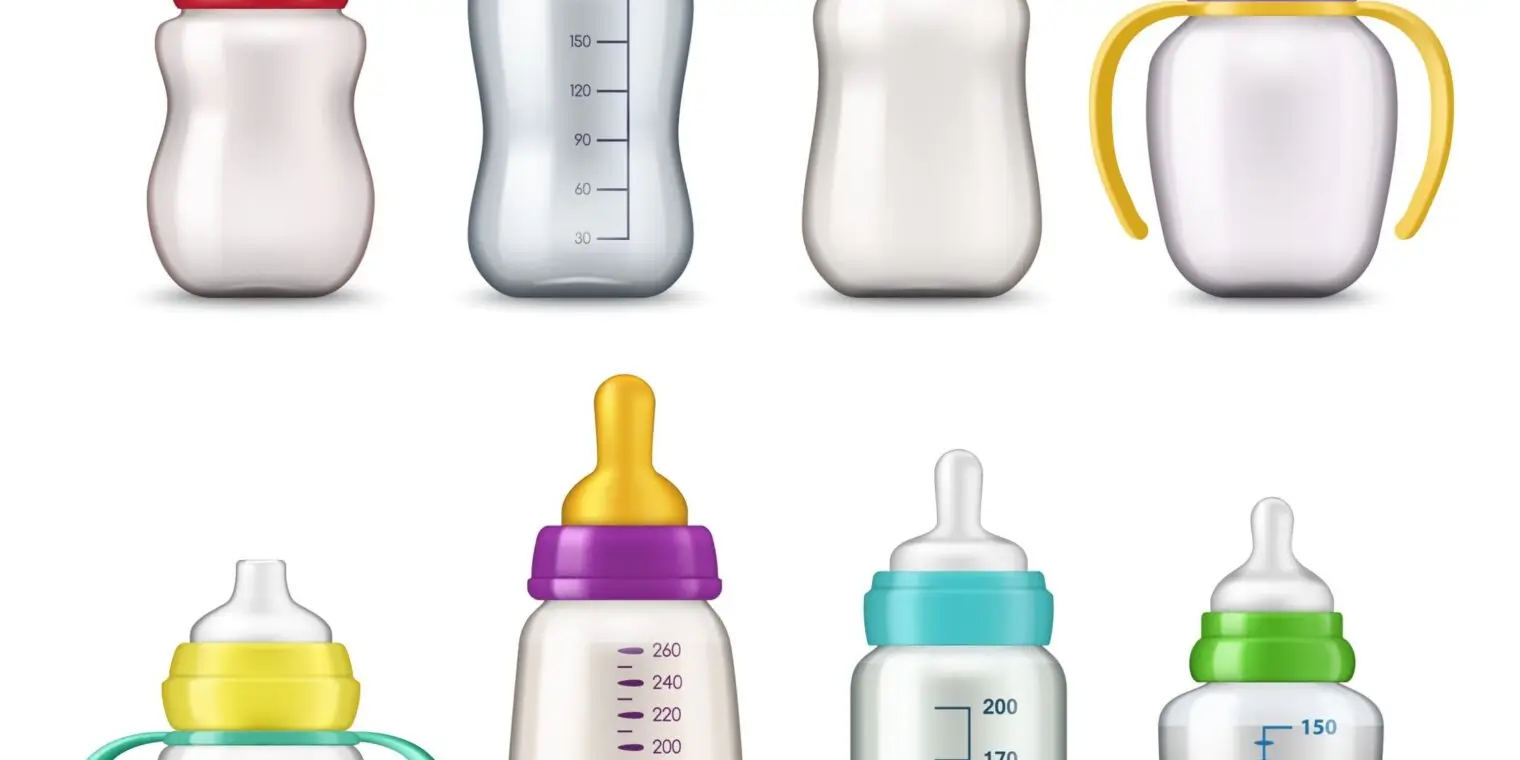
As an Amazon Associate Fed Is Best Foundation earns from qualifying purchases.
Material Components of Bottles
The following is supplementary material to Chapter 11: Bottle Feeding of the Fed Is Best book.
Plastic Bottles
Plastic bottles are the most common and most affordable bottle options. The advantages are that they don’t break when dropped, are light, and water does not condense on the outside when they contain cold fluids.
The AAP recommends using bottles labeled “Bisphenol A (BPA) free.[1,2]”, You can also look for the recycle symbols with the number 2 or 5 in them. Bottles with all other recycle codes may still contain BPA and should be avoided.
What is BPA? It’s an industrial chemical that is used for developing plastic containers. Research has shown that BPA can seep into food and beverages from plastic containers, and there is concern about endocrine system disruption, especially for babies and young children who are rapidly growing.
The FDA banned the use of BPA in baby bottles in 2012.[3]
Price: Starts at less than $1 USD per bottle
Glass Bottles
Glass bottles have a smooth surface and do not have any BPA that will seep into your baby’s milk. Glass is also easy to clean, it retains its clarity even after boiling for sanitization, is durable and is recyclable, and therefore eco-friendly.
However, it can break if dropped and is heavier to hold when feeding your baby. Condensation from cold milk can make the bottle wet and slippery.
Ones with a silicone cover to reduce breakage are at the higher end of this range. Note: Some daycares may not approve glass bottles for safety reasons.
Price: $3 to $22 USD per bottle
Stainless Steel Bottles
Stainless steel does not have any BPA that will seep into your baby’s milk. It’s easy to clean and sanitize and can’t break if dropped, but it can dent.
Condensation can make the bottle wet and slippery when milk is cold. There are silicone covers and grips to help with this, but that can increase the cost per bottle.
Stainless steel is lightweight, durable, recyclable, and considered eco friendly. The downside is that you won’t be able to easily see how much milk your baby has consumed.
The benefit of this is that it may encourage closer following of infant satisfaction cues rather than specific amounts of milk to determine when a feeding session ends, reducing the risk of overfeeding, if a parent is concerned. Parents using this type of bottle should make sure their infants appear happy, satisfied and are growing well on a growth chart.
Price: $6–25 per bottle
Silicone Bottles
Silicone bottles are among the newest types of baby bottles around. Silicone bottles are BPA free and can be sanitized in the dishwasher or boiled in water. They’re very soft and squishy for babies to touch.
They are also easy to clean, are lightweight, and don’t produce condensation. They do cost more than a standard plastic bottle.
Price: $6–17 USD per bottle
Pumping Compatible
These bottles are usually plastic, can attach directly to a breast pump while pumping, and are designed to collect and store breast milk. They come with nipples, collars, caps and nipple covers.
Usually, each breast pump manufacturer has a bottle system that goes with it, along with nipples that can be changed as a baby grows.
Price: starts at $2–4 per bottle
Bottles with Disposable Liners
These bottles are clear plastic tubes that have an opening at the bottle. They use plastic liners that hold formula or breast milk within the chamber.
The plastic liners are inserted from the top and folded over the top edge of the bottle where the nipple collar secures the liner and seals the bottle. The liners are disposable, making them ideal for travel or for those who want to minimize washing bottle containers.
Air bubbles can be squeezed out by holding the bottle upright and purging the air out of the nipple by squeezing the inner liner from the open bottom. Gently squeeze the liner until all of the air is released through the nipple.
As your baby drinks, the liner will collapse, thus eliminating the mixture of air with the milk. The liners are single use, disposable, and are BPA free.
For those concerned about plastic waste, they are advertised as recyclable, but differences in the type of plastic accepted by your local recycling facilities may make them effectively unrecyclable.
Price: $3 USD per bottle plus $0.10 per liner
Angled Bottles
Angled bottles have a 30 degree bend at the top third portion of the bottle. They’re designed to promote an optimal, upright feeding position, while keeping milk in the nipple to reduce air bubbles.
These bottles often have a vent at the bottom of the bottle to prevent air from bubbling through the milk. The bottle makes it easier for parents to feed their baby in an upright position as the bend helps funnel the milk towards the nipple and reduces introduction of air into the bottle through the nipple hole.
Price: $3–5 USD
To learn more about this topic, read the Fed Is Best book available on paperback, e-book, and audiobook.
References
- Trasande L, Shaffer RM, Sathyanarayana S; COUNCIL ON ENVIRONMENTAL HEALTH. Food Additives and Child Health. Pediatrics. 2018;142(2):e20181408, https://doi.org/10.1542/peds.2018-1408.
- “Baby Bottles and Bisphenol A (BPA) – HealthyChildren.Org,” accessed August 1, 2021, https://www.healthychildren.org/English/ages-stages/baby/feeding-nutrition/Pages/Baby-Bottles-And-Bisphenol-A-BPA.aspx.
- Center for Food Safety and Applied Nutrition, “Bisphenol A (BPA): Use in Food Contact Application,” FDA, February 22, 2021, https://www.fda.gov/food/food-additives-petitions/bisphenol-bpa-use-food-contact-application.
